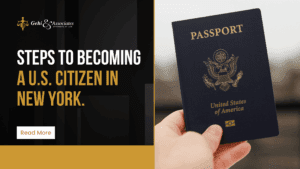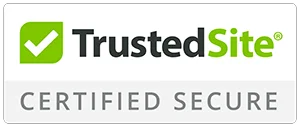
The benefits of obtaining citizenship in New York are significant. They include the right to vote, security from deportation, and access to a U.S. passport, among others. In neighborhoods from Jackson Heights to Jamaica, permanent residents are quietly taking the life-changing step of becoming U.S. citizens.
Many New Yorkers don’t know where to begin or what to expect next. The bureaucratic demands of Form N-400, interviews, biometrics, and wait times can be overwhelming. Despite the benefits, the path to citizenship demands detailed preparation, knowledge of USCIS procedures, and awareness of strict eligibility rules.
Queens Immigration Attorney breaks down the process of obtaining a U.S. citizenship in New York, step by step. Our attorneys use official resources and localized insights. We’ll take you through everything, from filing Form N-400 to preparing for your biometrics and interview. To have you standing proudly at your oath ceremony.
Key Insights:
- Most applicants must attend 3 major appointments: biometrics, the interview, and the oath ceremony.
- Typical processing times for naturalization range from 8 to 12 months, depending on the case and location.
- Applicants can file up to 90 days before meeting their 3- or 5-year permanent residency requirement.
- At least 30 months of physical presence in the U.S. is required in the 5-year eligibility track.
- Applicants must have resided in New York State or a USCIS district for at least 3 months before filing.
- Local oath ceremonies are typically held within 2 to 6 weeks of a successful interview in NYC.
- Continuous residence can be broken by international trips longer than 6 months.
How to File for U.S. Citizenship in New York
Applying for citizenship in New York begins with Form N-400. Filling out the form isn’t just paperwork; it’s a legal process with real consequences. USCIS doesn’t make exceptions for good intentions. Your Form N-400 must be completed exactly as directed. With accurate data, full supporting documentation, and timely submission of fees. The federal form is the same in every state, but processing times and field office practices vary. A qualified immigration attorney is your best resource if you want your case handled properly the first time.
Preparing Your Application
Preparation begins with evidence. You must provide supporting documents to verify your eligibility and establish identity, residency, and legal background. Without complete evidence, USCIS may reject your case, or worse, deny it after months of waiting.
Start your preparation with these essential items:
- A copy (front and back) of your Permanent Resident Card (green card).
- Documentation of your marital history, such as marriage certificates, divorce decrees, or death certificates.
- Travel history covering every trip outside the U.S. in the last 3 or 5 years.
- IRS tax transcripts, especially if USCIS suspects nonpayment or inconsistencies.
- Any arrest reports, court dispositions, or sentencing records if you’ve ever had legal issues.
All foreign-language documents must include a certified English translation. You must print in black ink and write “N/A” or “NONE” where applicable. Failure to do so may result in rejection of your form. Applicants with disabilities requesting exemptions from the English or civics test must also include Form N-648. This must be certified by a licensed medical professional.
Supporting documentation must match the legal claims in your application. If you say you’ve been married for 3 years to a U.S. citizen, your file must include:
- Proof your spouse is a U.S. citizen (passport, certificate of naturalization, etc.).
- Evidence of continuous marital union and joint residence.
- Proof of your lawful permanent residency for at least 3 years.
Filing Methods: Online vs Paper
USCIS offers 2 options to submit Form N-400: online and by mail. The online option is faster for updates and easier to track, but not everyone qualifies.
Online filing requires a USCIS account. If you’re paying the full filing fee, you can apply and upload scanned copies of your supporting documents electronically. USCIS will notify you of receipt and provide your biometric appointment letter through your account dashboard.
Paper filing is required if you request:
- A reduced fee, or
- A full fee waiver (Form I-912).
According to USCIS instructions, applicants using paper must print, avoid correction fluid, and sign by hand. Submitting payment by check or Form G-1450 for credit card use is also mandatory. If you forget to sign, USCIS will reject your entire application. Paper applicants still receive a USCIS Account Acceptance Notice. This enables them to create an online account for tracking cases. This hybrid system blends paper submission with digital monitoring.
Online filing may save a few days, but a poorly prepared case delays approval by months. The most reliable way to file is with a properly reviewed packet prepared with the help of a professional.
What to Expect in Queens, NY?
USCIS field offices in Queens are among the busiest. If you file from Queens, your case will likely be processed through the Queens Field Office or the Manhattan location. This depends on your ZIP code and USCIS workload.
Here’s what to expect in Queens:
- Longer wait times for interviews and biometrics appointments.
- High demand for interpreters across many languages.
- Delays during summer months and around holiday seasons.
- Crowded waiting rooms and rescheduling bottlenecks.
Many Queens residents move between boroughs or units. Failing to update your address promptly can result in missed USCIS notices and appointment letters. Always use a stable mailing address and ideally, consult with a local attorney who can track your mail and status.
Common Mistakes That Cause Rejections
Every year, thousands of applicants make avoidable errors. The top five mistakes USCIS flags:
- Failing to sign the form.
- Submitting incorrect fees.
- Missing supporting evidence, like tax transcripts or marital history.
- Providing inconsistent answers across sections.
- Not disclosing travel, arrests, or prior immigration violations.
Another frequent issue is misunderstanding what “continuous residence” means. For instance, a 7-month trip abroad may break your continuous residence, disqualifying you, even if you never thought it mattered. An experienced Queens immigration attorney can review your travel history. Determining whether you meet the physical presence and residency requirements. Fixing an error after filing is hard. USCIS rarely allows you to correct issues mid-process. Prevention is key, and legal review can catch things you may overlook.
Professional Guidance vs DIY
Do-it-yourself applications may seem easy, especially with USCIS offering online filing tools. However, most denials happen because applicants underestimate the legal complexity behind the form. In Queens, residents share mailboxes, switch apartments, or travel to visit family abroad. A Queens immigration attorney can spot issues that online services miss, just read reviews from clients.
Hiring an attorney is especially important if:
- You’ve had arrests or tax problems.
- You’ve taken long international trips.
- You’ve changed your name or used multiple aliases.
- You have disability waivers or medical conditions.
What Happens After You File for U.S. Citizenship in New York?
Once you submit Form N-400, the naturalization journey doesn’t stop. It only shifts into the next phase. For many applicants applying for citizenship in New York, the post-filing stage raises more questions than any other. People often ask: How long until I get called in? What happens first? What can delay my case?
The Typical NYC Timeline
After filing Form N-400, applicants in New York City usually wait between 8 to 12 months for the process to complete. This range covers the full sequence, from receipt notice to the oath ceremony. However, this estimate depends heavily on your case specifics and USCIS’s current workload. Here’s a basic outline of how the timeline unfolds in NYC:
- Within 10–14 days: You receive a receipt notice confirming your application.
- Within 3–6 weeks: You receive a biometrics appointment notice.
- Within 6–9 months: You attend your naturalization interview.
- Within 2–6 weeks after interview: You receive your oath ceremony date.
If you filed a strong, well-documented application, your case might move closer to the 8-month mark.
Biometric Appointment Details
The biometrics stage is required for nearly all applicants. USCIS uses this appointment to collect your fingerprints, digital photo, and signature. They use this data to run background checks and confirm your identity. You must attend this appointment at the exact time and date listed, no walk-ins.
Here’s what you need to know:
- USCIS will mail your biometric appointment letter with location, time, and instructions.
- Bring your appointment notice and Green Card to the center.
- Dress professionally; USCIS may use the photo for your Certificate of Naturalization.
Preparing for Your Naturalization Interview
The naturalization interview is the most critical step in your citizenship application. It usually takes place at the USCIS Field Office handling your case. During the interview, an officer will go over your N-400 responses, assess your English and civics knowledge, and verify your eligibility.
Confused about next steps? The Queens immigration attorney citizenship process simplifies it for you.
FAQs
How long does it take to get a citizenship in New York? It typically takes 8 to 12 months after filing Form N-400 to complete the citizenship process. The timeline includes biometrics, the interview, and the oath ceremony. USCIS processing times in New York may be longer due to high application volume. Background checks and missing documents can also cause delays.
What documents are needed for U.S. citizenship in New York? You need your Permanent Resident Card (Green Card) to start the application. Additional required documents include tax transcripts, travel history, and any legal or court records. Marriage or divorce certificates are needed if your eligibility is based on marriage to a U.S. citizen. All foreign-language documents must have certified English translations.
What are the 5 requirements to become a U.S. citizen? Applicants must be at least 18 years old at the time of filing Form N-400. You must also have been a lawful permanent resident for the required time period. Continuous residence, physical presence, and good moral character are mandatory. Passing the English and civics test is the final step unless you qualify for an exemption.
How long is the citizenship interview? The interview usually lasts between 20 to 45 minutes, depending on your case complexity. During the interview, a USCIS officer reviews your Form N-400 and supporting documents. They’ll also administer the English and civics tests unless you’re exempt. Additional time may be needed if clarification or follow-up is required.
Can I get U.S. citizenship without a test? Yes, but only under specific circumstances defined by USCIS. You may qualify for an exemption from the English and civics tests due to age and long-term residency. Another route is submitting Form N-648, a medical waiver certified by a licensed doctor. This form must prove a disability or impairment that prevents test participation.
Apply for U.S. Citizenship in New York with a Trusted Queens Immigration Attorney
The path to U.S. citizenship in New York is straightforward when you understand the rules and follow every step precisely. Working with an experienced Queens immigration attorney gives you peace of mind and professional representation every step of the way. Your dream of U.S. citizenship is within reach if you prepare wisely and avoid preventable errors. So if you’re ready to stop waiting and start your journey, don’t go it alone. Book a free consultation today!




